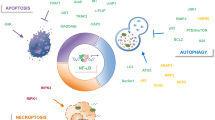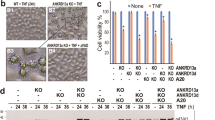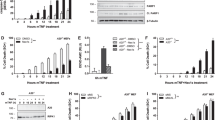Abstract
TNF-related apoptosis-inducing ligand (TRAIL) is a potent inducer of cell death in several cancer cells, but many cells are resistant to TRAIL. The mechanism that determines sensitivity to TRAIL-killing is still elusive. Here we report that deletion of TAK1 kinase greatly increased activation of caspase-3 and cell death after TRAIL stimulation in keratinocytes, fibroblasts and cancer cells. Although TAK1 kinase is involved in NF-κB pathway, ablation of NF-κB did not alter sensitivity to TRAIL. We found that TRAIL could induce accumulation of reactive oxygen species (ROS) when TAK1 was deleted. Furthermore, we found that TAK1 deletion induced TRAIL-dependent downregulation of cIAP, which enhanced activation of caspase-3. These results show that TAK1 deletion facilitates TRAIL-induced cell death by activating caspase through ROS and downregulation of cIAP. Thus, inhibition of TAK1 can be an effective approach to increase TRAIL sensitivity.
This is a preview of subscription content, access via your institution
Access options
Subscribe to this journal
Receive 50 print issues and online access
$259.00 per year
only $5.18 per issue
Buy this article
- Purchase on Springer Link
- Instant access to full article PDF
Prices may be subject to local taxes which are calculated during checkout





Similar content being viewed by others
References
Aggarwal BB . (2003). Signalling pathways of the TNF superfamily: a double-edged sword. Nat Rev Immunol 3: 745–756.
Ashkenazi A . (2002). Targeting death and decoy receptors of the tumour-necrosis factor superfamily. Nat Rev Cancer 2: 420–430.
Brockman JA, Scherer DC, McKinsey TA, Hall SM, Qi X, Lee WY et al. (1995). Coupling of a signal response domain in IκB alpha to multiple pathways for NF-kB activation. Mol Cell Biol 15: 2809–2818.
Chang L, Kamata H, Solinas G, Luo JL, Maeda S, Venuprasad K et al. (2006). The E3 ubiquitin ligase itch couples JNK activation to TNFα-induced cell death by inducing c-FLIP(L) turnover. Cell 124: 601–613.
Chen ZJ, Bhoj V, Seth RB . (2006). Ubiquitin, TAK1 and IKK: is there a connection? Cell Death Differ 13: 687–692.
Choo MK, Kawasaki N, Singhirunnusorn P, Koizumi K, Sato S, Akira S et al. (2006). Blockade of transforming growth factor-beta-activated kinase 1 activity enhances TRAIL-induced apoptosis through activation of a caspase cascade. Mol Cancer Ther 5: 2970–2976.
Hayden MS, Ghosh S . (2008). Shared principles in NF-κB signaling. Cell 132: 344–362.
Herrero-Martin G, Hoyer-Hansen M, Garcia-Garcia C, Fumarola C, Farkas T, Lopez-Rivas A et al. (2009). TAK1 activates AMPK-dependent cytoprotective autophagy in TRAIL-treated epithelial cells. EMBO J 28: 677–685.
Kajino T, Omori E, Ishii S, Matsumoto K, Ninomiya-Tsuji J . (2007). TAK1 MAPK kinase kinase mediates transforming growth factor-β signaling by targeting SnoN oncoprotein for degradation. J Biol Chem 282: 9475–9481.
Kamata H, Honda S, Maeda S, Chang L, Hirata H, Karin M . (2005). Reactive oxygen species promote TNFα-induced death and sustained JNK activation by inhibiting MAP kinase phosphatases. Cell 120: 649–661.
Karin M, Lin A . (2002). NF-κB at the crossroads of life and death. Nat Immunol 3: 221–227.
Kim J-Y, Omori E, Matsumoto K, Nunez G, Ninomiya-Tsuji J . (2008a). TAK1 is a central mediator of NOD2 signaling in epidermal cells. J Biol Chem 283: 137–144.
Kim SH, Ricci MS, El-Deiry WS . (2008b). Mcl-1: a gateway to TRAIL sensitization. Cancer Res 68: 2062–2064.
Kim Y, Suh N, Sporn M, Reed JC . (2002). An inducible pathway for degradation of FLIP protein sensitizes tumor cells to TRAIL-induced apoptosis. J Biol Chem 277: 22320–22329.
Kurbanov BM, Fecker LF, Geilen CC, Sterry W, Eberle J . (2007). Resistance of melanoma cells to TRAIL does not result from upregulation of antiapoptotic proteins by NF-κB but is related to downregulation of initiator caspases and DR4. Oncogene 26: 3364–3377.
LeBlanc HN, Ashkenazi A . (2003). Apo2L/TRAIL and its death and decoy receptors. Cell Death Differ 10: 66–75.
Li L, Thomas RM, Suzuki H, De Brabander JK, Wang X, Harran PG . (2004). A small molecule smac mimic potentiates TRAIL- and TNFα-mediated cell death. Science 305: 1471–1474.
Li ZW, Chu W, Hu Y, Delhase M, Deerinck T, Ellisman M et al. (1999). The IKKβ subunit of IκB kinase (IKK) is essential for nuclear factor κB activation and prevention of apoptosis. J Exp Med 189: 1839–1845.
Makris C, Godfrey VL, Krahn-Senftleben G, Takahashi T, Roberts JL, Schwarz T et al. (2000). Female mice heterozygous for IKKγ/NEMO deficiencies develop a dermatopathy similar to the human X-linked disorder incontinentia pigmenti. Mol Cell 5: 969–979.
Meng XW, Lee SH, Dai H, Loegering D, Yu C, Flatten K et al. (2007). Mcl-1 as a buffer for proapoptotic Bcl-2 family members during TRAIL-induced apoptosis: a mechanistic basis for sorafenib (Bay 43-9006)-induced TRAIL sensitization. J Biol Chem 282: 29831–29846.
Micheau O, Lens S, Gaide O, Alevizopoulos K, Tschopp J . (2001). NF-κB signals induce the expression of c-FLIP. Mol Cell Biol 21: 5299–5305.
Ninomiya-Tsuji J, Kishimoto K, Hiyama A, Inoue J, Cao Z, Matsumoto K . (1999). The kinase TAK1 can activate the NIK-IκB as well as the MAP kinase cascade in the IL-1 signalling pathway. Nature 398: 252–256.
Omori E, Matsumoto K, Sanjo H, Sato S, Akira S, Smart RC et al. (2006). TAK1 is a master regulator of epidermal homeostasis involving skin inflammation and apoptosis. J Biol Chem 281: 19610–19617.
Omori E, Morioka S, Matsumoto K, Ninomiya-Tsuji J . (2008). TAK1 regulates reactive oxygen species and cell death in keratinocytes, which Is essential for skin integrity. J Biol Chem 283: 26161–26168.
Petersen SL, Wang L, Yalcin-Chin A, Li L, Peyton M, Minna J et al. (2007). Autocrine TNFα signaling renders human cancer cells susceptible to Smac-mimetic-induced apoptosis. Cancer Cell 12: 445–456.
Reed JC . (2006). Drug insight: cancer therapy strategies based on restoration of endogenous cell death mechanisms. Nat Clin Pract Oncol 3: 388–398.
Ricci MS, Kim SH, Ogi K, Plastaras JP, Ling J, Wang W et al. (2007). Reduction of TRAIL-induced Mcl-1 and cIAP2 by c-Myc or sorafenib sensitizes resistant human cancer cells to TRAIL-induced death. Cancer Cell 12: 66–80.
Rudolph D, Yeh WC, Wakeham A, Rudolph B, Nallainathan D, Potter J et al. (2000). Severe liver degeneration and lack of NF-κB activation in NEMO/IKKγ-deficient mice. Genes Dev 14: 854–862.
Sato S, Sanjo H, Takeda K, Ninomiya-Tsuji J, Yamamoto M, Kawai T et al. (2005). Essential function for the kinase TAK1 in innate and adaptive immune responses. Nat Immunol 6: 1087–1095.
Shim J-H, Xiao C, Paschal AE, Bailey ST, Rao P, Hayden MS et al. (2005). TAK1, but not TAB1 or TAB2, plays an essential role in multiple signaling pathways in vivo. Genes Dev 19: 2668–2681.
Siegmund D, Mauri D, Peters N, Juo P, Thome M, Reichwein M et al. (2001). Fas-associated death domain protein (FADD) and caspase-8 mediate up-regulation of c-Fos by Fas ligand and tumor necrosis factor-related apoptosis-inducing ligand (TRAIL) via a FLICE inhibitory protein (FLIP)-regulated pathway. J Biol Chem 276: 32585–32590.
Takaesu G, Surabhi RM, Park KJ, Ninomiya-Tsuji J, Matsumoto K, Gaynor RB . (2003). TAK1 is Critical for IkB Kinase-mediated Activation of the NF-κB Pathway. J Mol Biol 326: 105–115.
Takeda K, Stagg J, Yagita H, Okumura K, Smyth MJ . (2007). Targeting death-inducing receptors in cancer therapy. Oncogene 26: 3745–3757.
Varfolomeev E, Maecker H, Sharp D, Lawrence D, Renz M, Vucic D et al. (2005). Molecular determinants of kinase pathway activation by Apo2 ligand/tumor necrosis factor-related apoptosis-inducing ligand. J Biol Chem 280: 40599–40608.
Ventura JJ, Cogswell P, Flavell RA, Baldwin Jr AS, Davis RJ . (2004). JNK potentiates TNF-stimulated necrosis by increasing the production of cytotoxic reactive oxygen species. Genes Dev 18: 2905–2915.
Vince JE, Wong WW, Khan N, Feltham R, Chau D, Ahmed AU et al. (2007). IAP antagonists target cIAP1 to induce TNFalpha-dependent apoptosis. Cell 131: 682–693.
Wang CY, Mayo MW, Korneluk RG, Goeddel DV, Baldwin Jr AS . (1998). NF-κB antiapoptosis: induction of TRAF1 and TRAF2 and c-IAP1 and c-IAP2 to suppress caspase-8 activation. Science 281: 1680–1683.
Wang L, Du F, Wang X . (2008). TNF-α induces two distinct caspase-8 activation pathways. Cell 133: 693–703.
Wang S, El-Deiry WS . (2003). TRAIL and apoptosis induction by TNF-family death receptors. Oncogene 22: 8628–8633.
Xiao C, Yang BF, Asadi N, Beguinot F, Hao C . (2002). Tumor necrosis factor-related apoptosis-inducing ligand-induced death-inducing signaling complex and its modulation by c-FLIP and PED/PEA-15 in glioma cells. J Biol Chem 277: 25020–25025.
Acknowledgements
We thank Drs Akira, Karin, Ballard and Wang for materials. This work was supported by a grant (GM068812) from NIH to JN-T.
Author information
Authors and Affiliations
Corresponding author
Additional information
Supplementary Information accompanies the paper on the Oncogene website (http://www.nature.com/onc)
Supplementary information
Rights and permissions
About this article
Cite this article
Morioka, S., Omori, E., Kajino, T. et al. TAK1 kinase determines TRAIL sensitivity by modulating reactive oxygen species and cIAP. Oncogene 28, 2257–2265 (2009). https://doi.org/10.1038/onc.2009.110
Received:
Revised:
Accepted:
Published:
Issue Date:
DOI: https://doi.org/10.1038/onc.2009.110
Keywords
This article is cited by
-
Roles of RIPK3 in necroptosis, cell signaling, and disease
Experimental & Molecular Medicine (2022)
-
Targeting bone morphogenetic protein receptor 2 sensitizes lung cancer cells to TRAIL by increasing cytosolic Smac/DIABLO and the downregulation of X-linked inhibitor of apoptosis protein
Cell Communication and Signaling (2019)
-
TAK1 suppresses RIPK1-dependent cell death and is associated with disease progression in melanoma
Cell Death & Differentiation (2019)
-
Noncanonical cell death program independent of caspase activation cascade and necroptotic modules is elicited by loss of TGFβ-activated kinase 1
Scientific Reports (2017)
-
TAK1 regulates hepatic lipid homeostasis through SREBP
Oncogene (2016)



